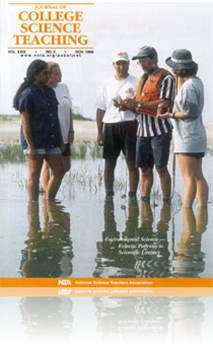All Journal of College Science Teaching resources
Journal Article
Classroom experiments are often designed for convenience, ignoring fundamental scientific processes. Even “hands-on” experiences seldom allow the student to define the problem or design the experiment. The example outlined here incorporates the e...
Journal Article
Favorite Demonstration: The Laporte Selection Rule in Electronic Absorption Spectroscopy
The Laporte selection rule states that electronic transitions between two gerade (g) states are forbidden; electronic transitions between two ungerade (u) states are forbidden; and electronic transitions between a gerade state and an ungerade are all...
Journal Article
The best way for students to discover how DNA sequences confirm descent with modification is to let them analyze data from the public sequence databases themselves. But first they must understand the significance of the sequences, and of variations i...
Journal Article
This column shares reflections or thoughtful opinions on issues of broad interest to the community. In this month’s issue, the author discusses the question of proper usage of the scientific vocabulary—it’s not new and continues to be argued....
Journal Article
Journal Articles as Case Studies: The New England Journal of Medicine on Lactose Intolerance
Students use as the basis for a case study a journal article investigating whether people who claimed to have severe lactose intolerance really were unable to digest lactose. This type of case is referred to as an “issues” or “analysis” type ...
Journal Article
Editorial: Headwinds Over Kansas—Making Good on Our Commitment to Science Education
The Journal of College Science Teaching’s editor shares thoughts regarding the current issue....
Journal Article
This column provides original articles on innovations in case study teaching, assessment of the method, as well as case studies with teaching notes. In this month’s issue, the case study was inspired by a novel assignment that Pace University Profe...
Journal Article
Research and Teaching: Contemporary Student Attitudes About Mathematics, Science, and Technology
To more effectively educate their students at Drury College in Springfield, Missouri, the authors developed a new, integrated science and mathematics curriculum (Deeds 1999) that emphasizes the nature of science and how we acquire scientific knowledg...



